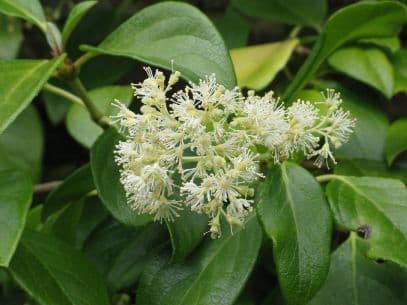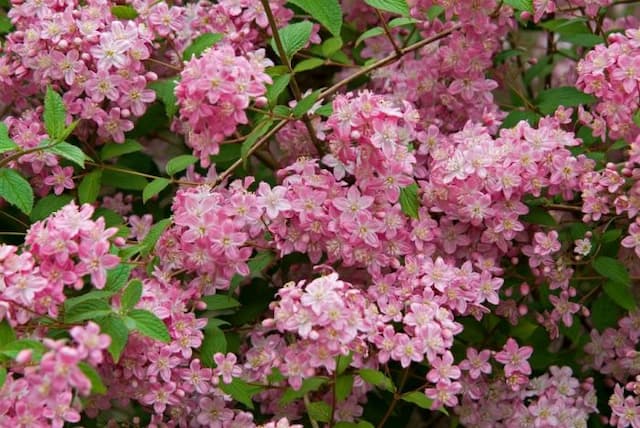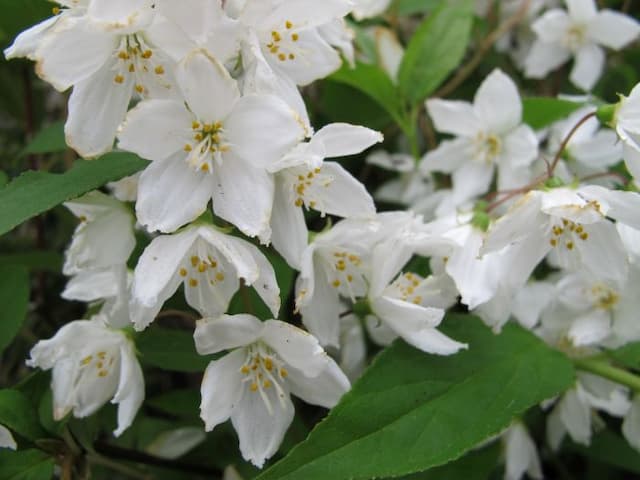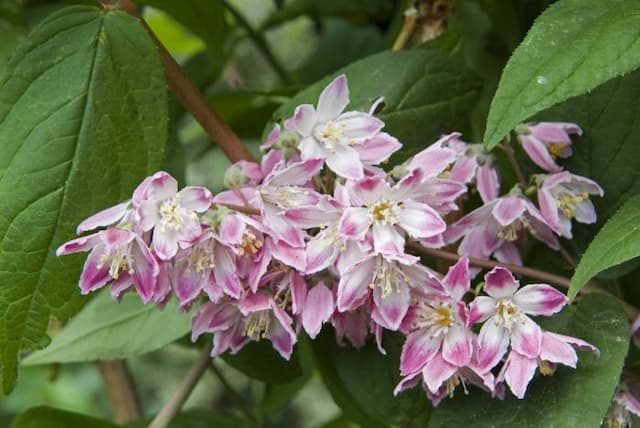Bobo Hydrangea Hydrangea paniculata Bobo = 'Ilvobo' (PBR)
![paniculate hydrangea [Bobo]](/_next/image?url=https%3A%2F%2Fplants-admin.emdemapps.com%2Fimages%2Fplants%2F%2Fimages%2F604b540e34610.png&w=3840&q=75)
ABOUT
The Hydrangea paniculata Bobo, commonly known as the Bobo hydrangea, is an ornamental shrub that is known for its stunning flowers. Its appearance is characterized by large, dense cone-shaped clusters of flowers. These blooms typically start as a soft green color and transition through shades of white, eventually acquiring a pink blush as they mature through the season. The flowers are held aloft on sturdy stems that rise above the foliage. The leaves of the Bobo hydrangea have a rounded to ovate shape and are a rich, deep green hue, creating a lush backdrop for the prominent flower heads. The foliage has a smooth texture and occasionally you may see serrated edges. The plant's foliage is deciduous, which means it sheds its leaves annually. Bobo hydrangeas are often noted for their compact and rounded form, which creates a dense and full appearance. This attribute makes them particularly attractive for use in smaller garden spaces or even in container plantings, where their bountiful floral display can be enjoyed up close. The flowers of the Bobo hydrangea provide a dramatic visual impact during blooming season and also attract pollinators, adding a dynamic element to the garden.
About this plant
 Names
NamesFamily
Hydrangeaceae.
Synonyms
Bobo Hydrangea, Dwarf Panicle Hydrangea, Miniature Hydrangea.
Common names
Hydrangea paniculata 'Ilvobo'.
 Toxicity
ToxicityTo humans
The common name for Hydrangea paniculata 'Ilvobo' is Bobo hydrangea. Bobo hydrangea is known to contain compounds that can be toxic to humans if ingested. The toxicity is due to the presence of amygdalin, a cyanogenic glycoside. When ingested, amygdalin can hydrolyze to hydrogen cyanide, which is poisonous. Symptoms of poisoning may include gastrointestinal distress, such as vomiting and diarrhea, as well as more serious symptoms like dizziness, difficulty breathing, convulsions, and, in severe cases, may lead to coma or death. It is advisable to avoid ingesting any part of the plant and to seek medical attention immediately if ingestion occurs.
To pets
The common name for Hydrangea paniculata 'Ilvobo' is Bobo hydrangea. Bobo hydrangea is toxic to pets, with both cats and dogs being susceptible to its effects. The toxic principle in the plant is amygdalin, which can release hydrogen cyanide when metabolized. If a pet ingests parts of a Bobo hydrangea, they may experience symptoms such as vomiting, diarrhea, lethargy, abdominal pain, and depression. In severe cases, more dangerous symptoms like difficulty breathing and seizures may occur, which can be life-threatening. It is important to prevent pets from chewing on or consuming any parts of hydrangeas and to seek veterinary care immediately if you suspect your pet has ingested some.
 Characteristics
CharacteristicsLife cycle
Perennials
Foliage type
Deciduous
Color of leaves
Green
Flower color
White
Height
3 feet (0.91 meter)
Spread
4 feet (1.22 meters)
Plant type
Shrub
Hardiness zones
3
Native area
Asia
Benefits
 General Benefits
General Benefits- Compact Size: Ideal for small gardens or landscapes with limited space.
- Decorative Flowers: Produces large white flower panicles that turn pinkish as they age.
- Seasonal Interest: Offers visual interest from summer until fall, providing a long blooming period.
- Attracts Pollinators: Flowers attract bees, butterflies, and other beneficial insects to the garden.
- Low Maintenance: Requires minimal pruning and is easy to care for once established.
- Cold Hardy: Resistant to cold temperatures, making it suitable for cooler climates.
- Versatile Uses: Can be used in mixed borders, as a focal point, or in mass plantings.
- Deer Resistant: Less likely to be damaged by deer than other garden plants.
 Medical Properties
Medical PropertiesThis plant is not used for medical purposes.
 Air-purifying Qualities
Air-purifying QualitiesThis plant is not specifically known for air purifying qualities.
 Other Uses
Other Uses- Artistic inspiration: The Bobo hydrangea, with its abundant white flowers, can serve as a muse for artists and photographers seeking to capture the beauty of nature in their work.
- Educational tool: Horticulture students and botanical educators can use the Bobo hydrangea to demonstrate pruning techniques and discuss the care specific to Paniculata species.
- Decorative dried flowers: The blossoms of the Bobo hydrangea can be dried and used in floral arrangements or crafts, retaining their shape and color for extended periods.
- Festive decorations: During the winter holidays, branches of Bobo hydrangeas can be spray-painted with metallic colors and used as unique decorations or centerpieces.
- Garden design classes: This compact plant can be used in garden design and landscape architecture classes to illustrate how to incorporate dwarf shrubs into small spaces.
- Themed events: For weddings or events with a botanical theme, the Bobo hydrangea's clusters of flowers can be utilized as part of the decor, enhancing table settings or venue aesthetics.
- Children's garden projects: The shrub can be used to engage children in gardening, teaching them about plant growth and care through observation and hands-on experience.
- Culinary presentations: Though not for consumption, the Bobo hydrangea can add visual appeal to culinary displays, such as buffet setups or cake decorations, when used strictly as a non-toxic adornment.
- Color therapy: The white flowers of the Bobo hydrangea can be utilized in color therapy practices, providing a calming white environment meant to promote relaxation and mental clarity.
- Bee-friendly garden cultivation: By planting Bobo hydrangeas, gardeners contribute to the creation of a bee-friendly environment, supporting pollinator populations that are crucial for ecological balance.
Interesting Facts
 Feng Shui
Feng ShuiThe Bobo Hydrangea is not used in Feng Shui practice.
 Zodiac Sign Compitability
Zodiac Sign CompitabilityThe Bobo Hydrangea is not used in astrology practice.
 Plant Symbolism
Plant Symbolism- Heartfelt Emotions: Hydrangeas are often considered to symbolize the depth of feeling that comes from the heart, and giving a Bobo hydrangea may express genuine emotion or gratitude.
- Vanity or Frivolity: In some contexts, hydrangeas can represent vanity or boastfulness due to their showy and abundant flowers. The Bobo hydrangea's impressive blooms may sometimes carry this connotation.
- Understanding: The hydrangea can be a symbol of understanding and patience, perhaps due to their need for consistent care and watering, thus the Bobo hydrangea might convey a message of empathy or perseverance in relationships.
- Gratitude for Being Understood: Particular to the pink hydrangeas, these plants express appreciation for being fully understood by others. Although the Bobo hydrangea is not pink, it is a cultivar of the species and may still carry this meaning for some.
- Abundance: Hydrangeas produce lush clusters of flowers, which can symbolize abundance or prosperity. The Bobo hydrangea, with its densely packed blooms, might be given to wish someone a plentiful or rich life.
- Fourth Wedding Anniversary: Hydrangeas are sometimes associated with fourth wedding anniversaries, representing appreciation and heartfelt emotion, making the Bobo hydrangea a potential anniversary gift.
 Water
WaterBobo hydrangeas should be watered deeply and thoroughly, ensuring the soil is moist but not saturated, as overwatering can lead to root rot. For newly planted Bobo hydrangeas, water them every other day for the first week, then reduce watering to twice a week, providing about 1 gallon per plant at each watering session. During hot, dry spells, increase watering frequency as needed but allow the soil to dry out slightly between waterings. In general, water these hydrangeas early in the morning to reduce evaporation and minimize the risk of leaf diseases.
 Light
LightBobo hydrangeas thrive in full sun to partial shade. The best spot for planting them is where they can receive at least six hours of sunlight daily, which promotes strong growth and abundant blooms. If you live in a region with intense summer heat, provide some afternoon shade to protect the plant from excessive stress.
 Temperature
TemperatureBobo hydrangeas prefer a moderate climate with temperatures ideally between 60 and 80 degrees Fahrenheit. They are cold-hardy and can tolerate minimum temperatures down to about -30 degrees Fahrenheit but should be protected from extreme winter conditions. During the growing season, maintaining an environment within their ideal temperature range will support healthy growth and flowering.
 Pruning
PruningPrune Bobo hydrangeas to maintain shape and encourage new growth, which results in better flowering. The best time for pruning is late winter or early spring before new growth emerges. Cut back the previous year's growth to a pair of healthy buds to invigorate the plant. It's also beneficial to remove any dead or weak stems at this time to improve air circulation and plant health.
 Cleaning
CleaningAs needed
 Soil
SoilBobo Hydrangeas thrive in well-draining, fertile soil with a pH range of 5.5 to 6.5. A good mix would include peat moss, compost, and garden soil to improve structure and fertility. Amend with organic matter yearly to maintain soil quality.
 Repotting
RepottingDwarf Hydrangeas like Bobo generally don't need frequent repotting as they are often planted in the landscape. If grown in containers, repot every 2-3 years or when rootbound.
 Humidity & Misting
Humidity & MistingBobo Hydrangeas prefer moderate humidity. Average ambient outdoor humidity is adequate, and they do not require specific humidity adjustments when planted outdoors.
 Suitable locations
Suitable locationsIndoor
Bright light, high humidity, and moist soil; avoid direct sun.
Outdoor
Plant in partial sun, moist soil, and add organic mulch.
Hardiness zone
3-8 USDA
 Life cycle
Life cycleHydrangea paniculata 'Bobo' begins its life cycle as a dormant, bare-root plant or as a small potted nursery specimen. After planting, it enters a growth phase in spring where it develops a lush foliage of green leaves, followed by flowering in the summer, typically around July, when it produces large conical panicles of white flowers that may age to a pink hue as the season progresses. In autumn, the leaves may change color before they fall off as the plant enters dormancy in response to cooler temperatures and shorter days. Throughout winter, 'Bobo' endures the cold season with buds protected beneath its bark, ready for the next cycle of growth. The plant then re-emerges in the following spring, continuing the cycle with new leaf growth, leading to another season of flowering. This repeat pattern carries on year after year, with the shrub possibly increasing in size and bloom capacity as it matures.
 Propogation
PropogationPropogation time
Early Spring
Propogation: The most popular method of propagating Hydrangea paniculata 'Bobo' is through softwood cuttings, which is typically done in late spring to early summer. For this method, a gardener would cut a stem from the plant that has new growth but is not yet woody. The cut should be made just below a leaf node, and ideally, the cutting will be 4 to 6 inches (about 10 to 15 centimeters) in length. After removing the lower leaves to expose the nodes, the cut end is often dipped in rooting hormone to encourage root development. The cutting is then placed in a well-draining potting mix and kept moist until roots have developed, which usually takes several weeks. During this time, the cutting should be kept in indirect light and in a warm environment to promote rooting.






![Rose deutzia [Yuki Cherry Blossom]](/_next/image?url=https%3A%2F%2Fplants-admin.emdemapps.com%2Fimages%2Fplants%2F%2Fimages%2F604b6510a383a.png&w=640&q=75)
![Hydrangea [Hot Chocolate]](/_next/image?url=https%3A%2F%2Fplants-admin.emdemapps.com%2Fimages%2Fplants%2F%2Fimages%2F604b5a066e3bd.png&w=640&q=75)
![Hydrangea [Blackberry Pie]](/_next/image?url=https%3A%2F%2Fplants-admin.emdemapps.com%2Fimages%2Fplants%2F%2Fimages%2F604b56e2abc1d.png&w=640&q=75)
